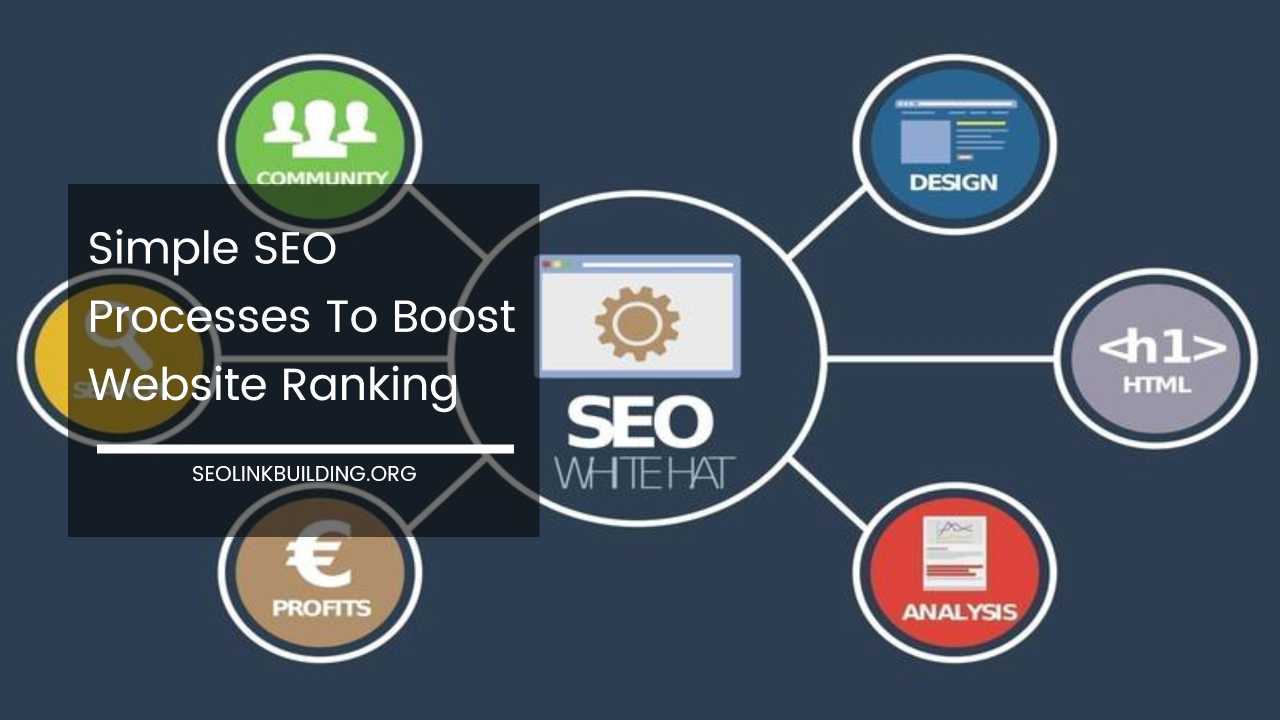Simple SEO Techniques for Powerful Results

Simple SEO Processes To Boost Website Ranking
In today’s digital age, a strong online presence is no longer a luxury; it’s a necessity. Search Engine Optimization (SEO) is the key to unlocking that potential, ensuring your website ranks higher in search results and attracts more organic traffic.
While SEO can seem complex, there are numerous simple processes you can implement to significantly boost your website ranking.
This comprehensive guide dives into the core aspects of SEO, providing actionable steps you can take to improve your website’s visibility and user experience. Here’s what we’ll cover:
- Understanding SEO Fundamentals
- Keyword Research and Targeting Strategies
- Crafting Content that Search Engines and Users Love
- On-Page Optimization Techniques for Maximum Impact
- Building Backlinks: The Currency of Authority
- Technical SEO Considerations for a Flawless Foundation
- Measuring SEO Success: Tracking Progress for Improvement
- Bonus SEO Tips for a Competitive Edge
Understanding SEO Fundamentals
Before diving into specific tactics, let’s establish a foundational understanding of SEO. Search engines like Google use complex algorithms to rank websites based on various factors. These factors can be broadly categorized into three areas:
- Content: The quality, relevance, and value your website offers to users.
- On-Page Optimization: How well your website is structured and optimized for search engines.
- Backlinks: The number and quality of links from other websites pointing to yours.
By focusing on these core areas, you can significantly improve your website’s ranking potential.
Keyword Research and Targeting Strategies
Keywords are the search terms users type into search engines. Effective SEO starts with identifying relevant keywords that your target audience is actively searching for. Here’s how to approach keyword research strategically:
- Brainstorm Relevant Keywords: Consider what products, services, or information your website offers. What questions might users have related to your niche? Write down a comprehensive list of potential keywords.
- Utilize Keyword Research Tools: Several free and paid tools like Google Keyword Planner can help you discover search volume, competition level, and related keywords. These tools provide valuable insights into user search behavior.
- Target a Mix of Keywords: Include a healthy mix of high-volume keywords for broader reach and long-tail keywords (more specific phrases) for targeted traffic. Long-tail keywords often have lower competition and can be highly effective in attracting users with a clear buying intent.
Once you have a list of relevant keywords, integrate them strategically throughout your website content, including titles, meta descriptions, headings, and body text.
However, avoid keyword stuffing, which involves excessively using keywords in an unnatural way. Search engines penalize websites for this practice, and it can also negatively impact user experience.
Crafting Content that Search Engines and Users Love
Compelling, high-quality content is the backbone of SEO. Search engines prioritize websites that offer valuable and informative content that resonates with users.
Here are some tips for creating SEO-friendly content that both search engines and users will appreciate:
- Focus on User Intent: Understanding the purpose behind a user’s search query is critical. Conduct thorough research to understand the specific information users are seeking and tailor your content to address it directly.
- Create Informative and Engaging Content: Go beyond superficial information. Provide in-depth explanations, answer user questions comprehensively, and offer solutions to their problems. Consider including relevant statistics, data, and case studies to enhance the credibility and value of your content.
- Maintain Consistent Content Creation: Regularly publishing fresh content keeps your website active and relevant. Aim for a consistent publishing schedule, whether it’s weekly, bi-weekly, or monthly. This consistency signals to search engines that your website is a reliable source of information and encourages users to return for more.
- Optimize Content Length: While there’s no one-size-fits-all answer, search engines tend to favor content that is long enough to be informative. Aim for content that is ideally 1000+ words for in-depth topics. However, avoid sacrificing quality for length. Ensure your content remains concise, well-structured, and easy to read. Break up lengthy content with subheadings, bullet points, and images to improve readability.
On-Page Optimization Techniques for Maximum Impact
On-page optimization refers to optimizing the individual pages of your website for search engines. Here are some key aspects to focus on to maximize the impact of each page:
- Title Tags and Meta Descriptions: Craft compelling title tags (under 60 characters) and meta descriptions (under 160 characters) that accurately reflect your content and include relevant keywords. These snippets are like mini-advertisements for your website displayed in search results. Make them informative and enticing to encourage users to click.
- Headings and Subheadings: Structure your content using clear headings (H1 H2, H3, etc.) that incorporate keywords and break up text for readability. Headings act like signposts, guiding users through the content and improving its organization.
- Image Optimization: Use relevant filenames and alt tags for images. Filenames should be descriptive and include relevant keywords. Alt tags provide a text description of the image, which is crucial for search engines to understand the context of the image and improve accessibility for visually impaired users.
- Internal Linking: Link to other relevant pages within your website to improve user navigation and distribute ranking power throughout your site. Strategic internal linking creates a strong internal network of information, helping users find related content and keeping them engaged on your website.
Building Backlinks: The Currency of Authority
Backlinks are essentially votes of confidence from other websites pointing to yours. Search engines consider websites with a high number of quality backlinks to be more authoritative and trustworthy.
Here are some effective tactics to build backlinks and establish your website as a valuable resource:
- Guest Blogging: Contribute high-quality guest posts to reputable websites within your niche. Include a link back to your website within the content, providing users with a valuable resource and search engines with a clear signal of authority.
- Broken Link Building: Find broken links on relevant websites with content similar to yours. Reach out to the website owner and suggest your content as a replacement. This strategy provides value by fixing a broken link and offers users a relevant and informative alternative.
- Create Linkable Assets: Develop infographics, studies, or other valuable resources that other websites would naturally want to link to. This could include industry reports, comprehensive guides, or unique data visualizations. High-quality linkable assets establish your website as a thought leader and a go-to source of valuable information.
Technical SEO Considerations for a Flawless Foundation
Technical SEO ensures your website is crawlable and indexable by search engines. Here are some key aspects to address for a solid technical foundation:
- Mobile-friendliness: Ensure your website is optimized for mobile devices, as Google prioritizes mobile-friendly websites in search results. With the majority of web traffic now coming from mobile devices, a responsive design is no longer an option; it’s a necessity.
- Website Speed: Focus on improving website loading speed, as it significantly impacts user experience and SEO ranking. Slow loading times can frustrate users and cause them to abandon your website before they even see your content. Utilize website speed testing tools to identify areas for improvement and implement strategies like image optimization, code minification, and caching to improve loading times.
- Structured Data Markup: Implement schema markup to provide search engines with additional information about your content. Schema markup uses a specific vocabulary to categorize your content, potentially leading to richer search results. For example, schema markup can be used to display reviews, ratings, or event details directly in search snippets, making your listing more visually appealing and informative to users.
Measuring SEO Success: Tracking Progress for Improvement
SEO is an ongoing process, and tracking your progress is crucial to measure the effectiveness of your efforts and identify areas for improvement. Here are some key metrics to monitor:
- Organic Traffic: Track the amount of website traffic coming from organic search results. Tools like Google Analytics provide valuable insights into website traffic sources. Monitor organic traffic trends over time to assess the impact of your SEO efforts.
- Keyword Rankings: Monitor your website’s ranking for targeted keywords over time. Several free and paid tools can help you track rankings. Focus on improving your ranking for relevant keywords with high search volume and user intent.
- Engagement Metrics: Analyze metrics like bounce rate, time on site, and conversion rate to understand how users interact with your content. A high bounce rate might indicate that users are not finding the information they need or that your website is difficult to navigate. Analyze these metrics to identify areas for improvement and enhance user experience.
Bonus SEO Tips for a Competitive Edge
Here are some additional SEO tips to keep in mind to stay ahead of the curve:
- Local SEO: If you have a local business, optimize your website for local search by claiming your Google My Business listing and including relevant local keywords throughout your website content. Local SEO helps ensure your business shows up in search results for localized queries.
- Social Media Promotion: Actively promote your website content on social media platforms to drive traffic and engagement. Share valuable snippets of your content, infographics, or engaging videos to attract users from social media to your website.
- Stay Updated: Search engine algorithms are constantly evolving. Stay informed about the latest SEO trends and best practices by following industry publications and attending relevant webinars or conferences. This ensures your SEO strategy remains effective and adapts to the ever-changing search landscape.
Final Thoughts
By implementing these simple SEO processes, you can significantly improve your website’s ranking and visibility in search results.
Remember, SEO is a long-term strategy, and consistent effort is key to achieving sustainable success. Don’t be afraid to experiment, track your results, refine your approach, and stay updated on the latest trends. Here are some additional thoughts to consider:
- Prioritize User Experience: While SEO is crucial, never prioritize search engine optimization over user experience. Your website should be informative, user-friendly, and visually appealing. If users find your website difficult to navigate or frustrating to use, they’ll bounce back to the search results, ultimately harming your SEO efforts.
- Quality Over Quantity: Focus on creating high-quality content that provides genuine value to users. In-depth content that addresses user needs and search intent will naturally attract backlinks and establish your website as a trusted resource.
- Patience is Key: SEO is a marathon, not a sprint. It takes time and consistent effort to see significant results. Be patient, track your progress, and celebrate small victories along the way.
- Seek Professional Help: If you’re feeling overwhelmed or require more in-depth guidance, consider consulting with an SEO professional. They can provide a customized SEO strategy tailored to your specific website and niche.
By following these tips and applying the SEO processes outlined in this guide, you can empower your website to reach a wider audience, attract more organic traffic, and achieve long-term success in the ever-evolving world of search engine optimization.













